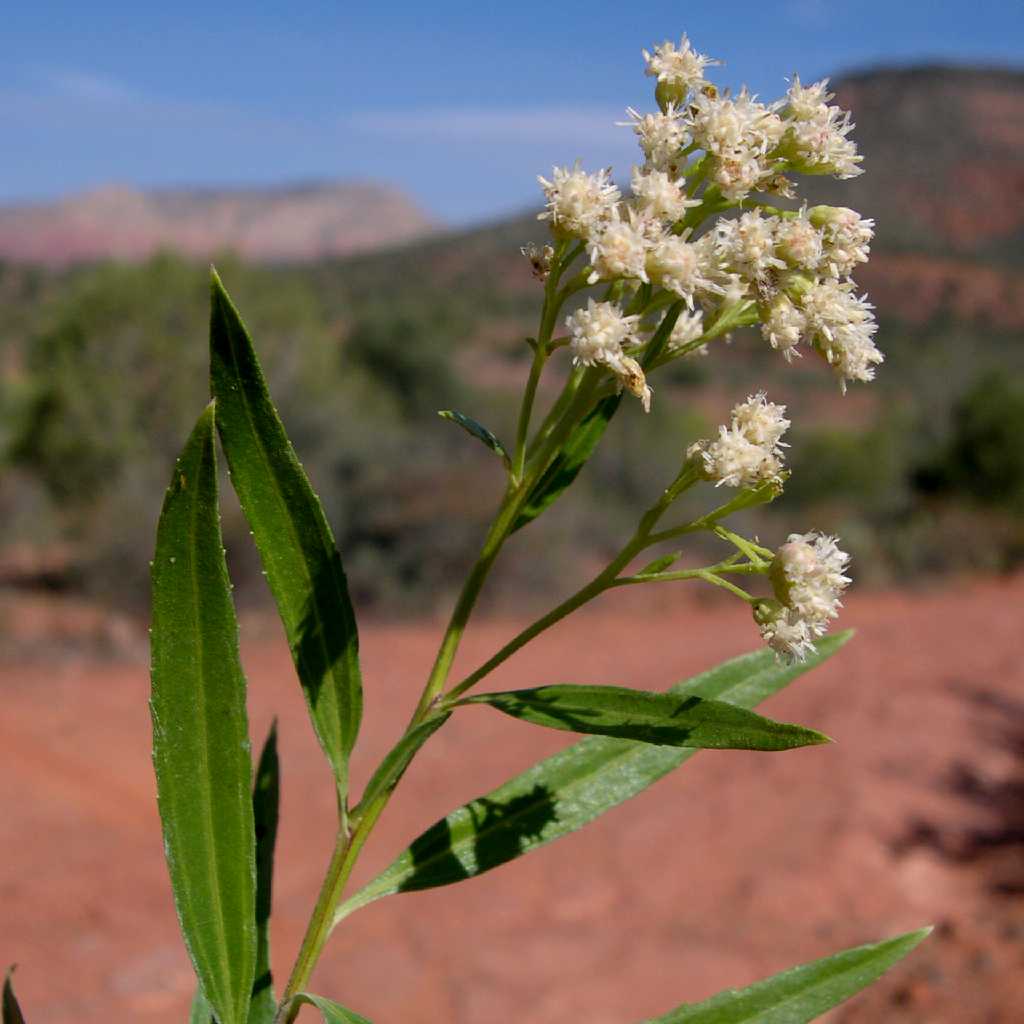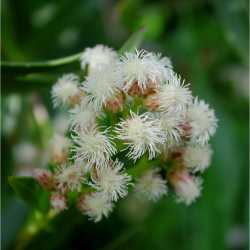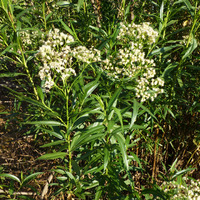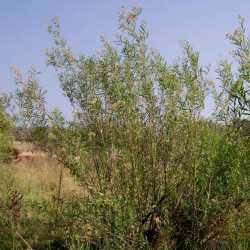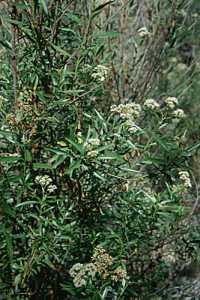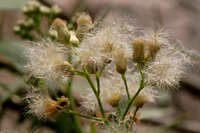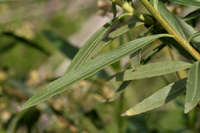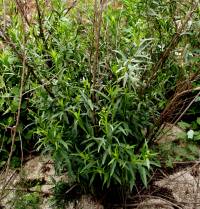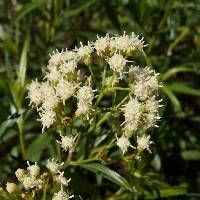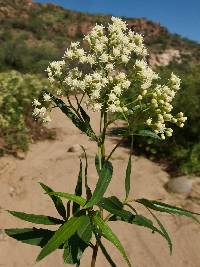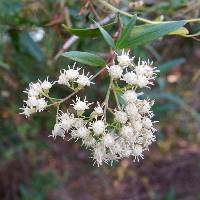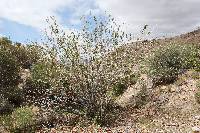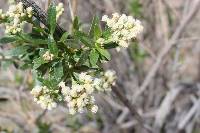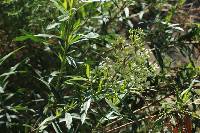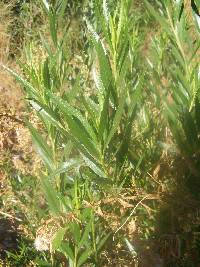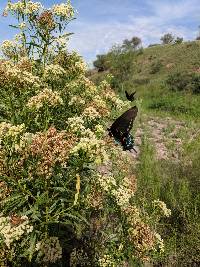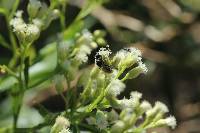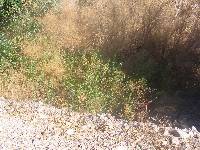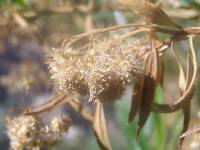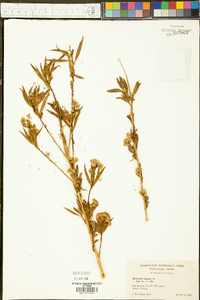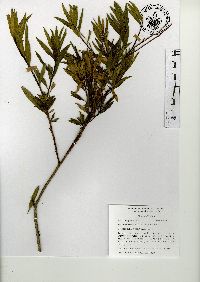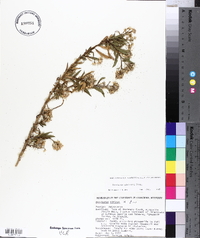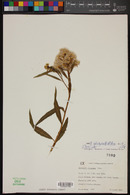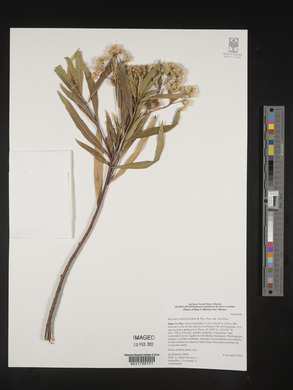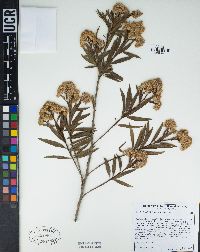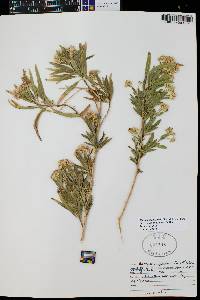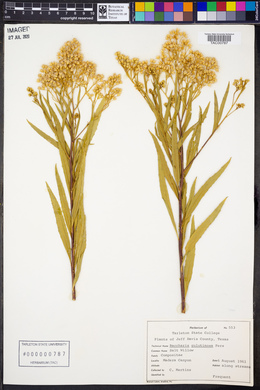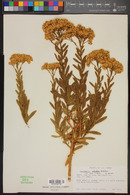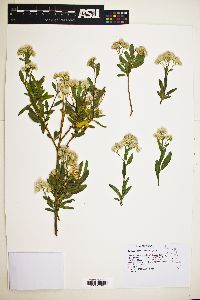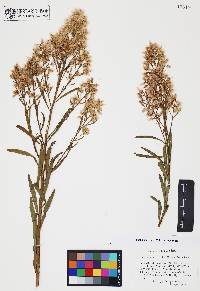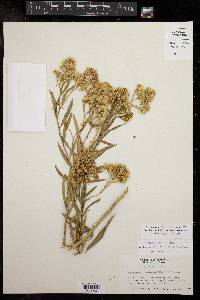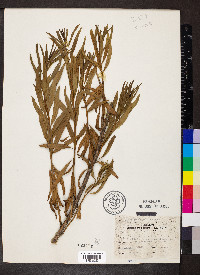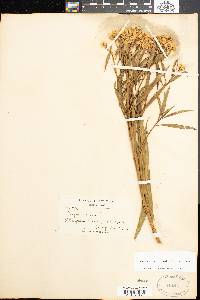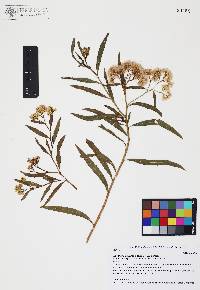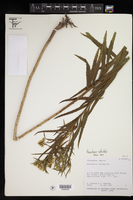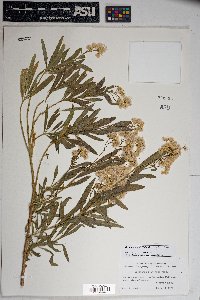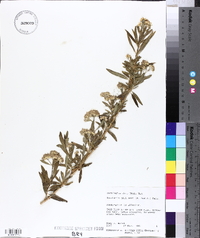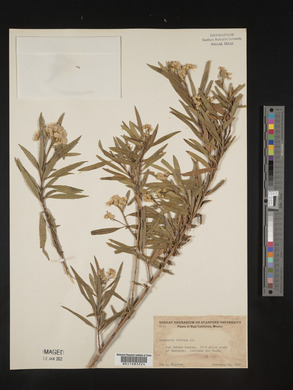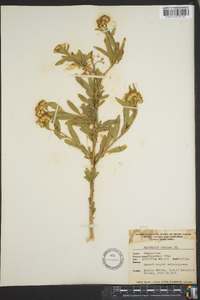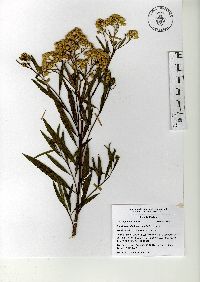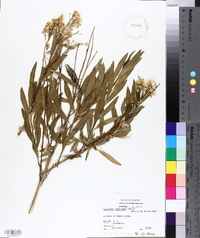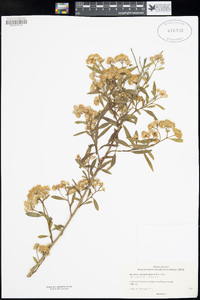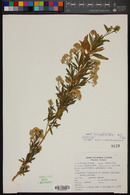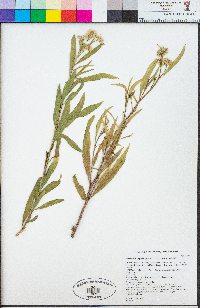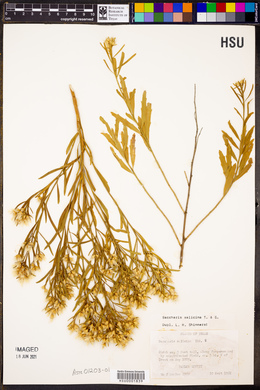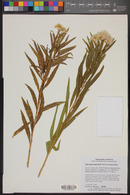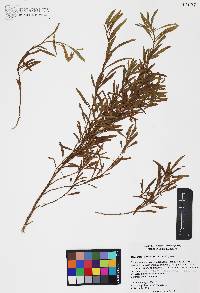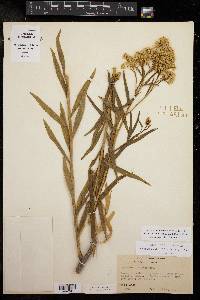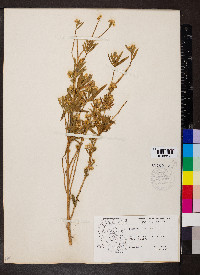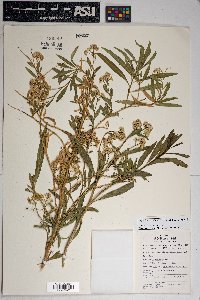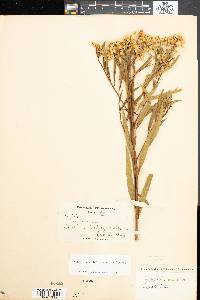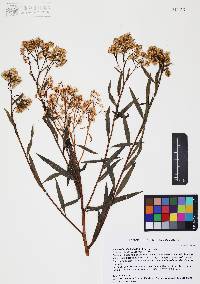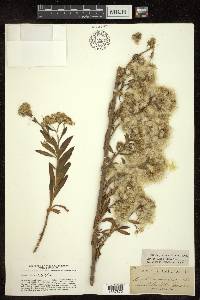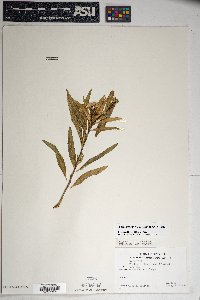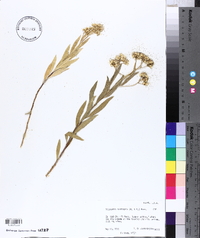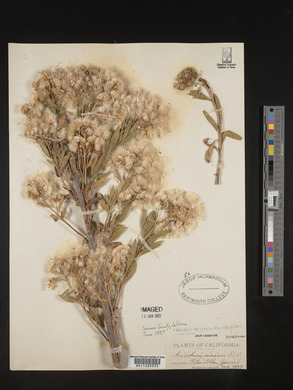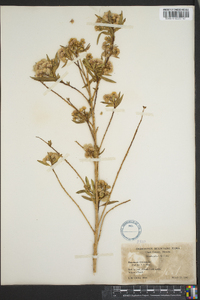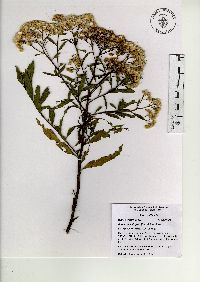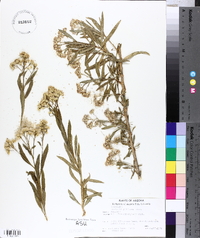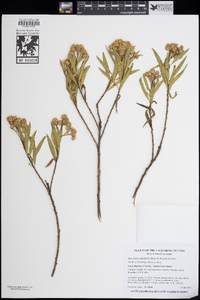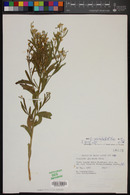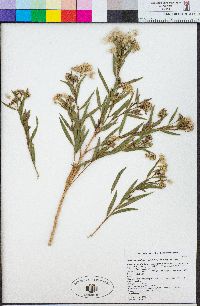Baccharis salicifolia
|
|
|
|
Family: Asteraceae
Douglas' False Willow, more...Mule's-Fat, water wally, mule-fat, seep-willow, mule's fat, seep willow, seepwillow, seepwillow baccharis (es: batamote, jarilla, hierba del pasmo, jarillla)
[Baccharis alamanii, moreBaccharis glutinosa Pers., Baccharis longifolia , Baccharis parviflora , Baccharis salicifolia var. salicifolia , Baccharis viminea DC., Baccharis viminea var. atwoodii S.L. Welsh, Baccharis viminea var. viminea DC., Molina salicifolia Ruiz & Pav.] |
Shrubs, 30-400 cm (stems cluster-ed). Stems spreading to ascending, green to tan, simple proximally, sparingly branched distally, striate-angled, glabrous or minutely hairy, resinous and ± resin-varnished. Leaves present at flowering (abundant, well developed); sessile or petiolate; blades lanceolate-elliptic, slightly falcate (willowlike), 30-150 × 3-20 mm, bases attenuate , margins usually finely serrate from bases to apices, sometimes entire, apices acute to acuminate, faces glabrous, gland-dotted, ± resinous. Heads in terminal, compound corymbiform arrays (often involving distal branches). Involucres hemispheric; staminate 3-6 mm, pistillate involucres 3-6 mm. Phyllaries ovate to lanceolate, 2-4 mm, margins scarious, erose or irregularly dentate, midribs distinct, medians green or reddish, apices (greenish or brownish purple) obtuse to acuminate (pale and dry, glabrous). Staminate florets (10-)17-48; corollas 4-6 mm. Pistillate florets 50-150; corollas 2-3.5 mm. Cypselae 0.8-1.5 mm, 5-nerved, glabrous; pappi 3-6 mm. 2n = 18, 36. Flowering (Jan-)Mar-Oct. Stream banks, dry washes, sandy flood plains, riparian woodlands, disturbed sites, ditches; 30-2400 m; Ariz., Calif., Colo., Nev., N.Mex., Tex., Utah; Mexico; South America. Baccharis salicifolia is part of a complex that extends through the southwestern United States, Mexico, Central America, and South America to Argentina and Chile (J. Cuatrecasas 1968). It is recognized by the narrowly lanceolate, willowlike, finely serrate leaves with acute or acuminate apices, smallish heads in dense clusters, reddish phyllaries, and 5-nerved cypselae. By tagging and measuring individual plants throughout the year, D. H. Wilken (1972) demonstrated that B. salicifolia has distinct seasonal forms. The North American plants were once known as B. glutinosa or B. viminea, which were differentiated from each other by differences in woodiness, leaf size and serration, and flowering time.
FNA 2006, Benson and Darrow 1981, Kearney and Peebles 1969, Heil et al 2013 Common Name: mule-fat Duration: Perennial Nativity: Native Lifeform: Shrub Wetland Status: FAC General: Dioecious shrub, 1-4 m tall, with a willow-like architecture; branches long, wand-like, tan. Leaves: Alternate, sessile or short-petiolate; blades lanceolate-elliptic and slightly falcate (willow-like), 3-15 cm long by 0.5-2 cm wide, the margins finely and evenly serrate, and the surfaces gland-dotted and more or less resinous. Flowers: Flower heads unisexual, discoid, arranged in terminal, flat-topped clusters; involucre (the ring of bracts surrounding the flower head) hemispheric, 3-6 mm tall, the bracts (phyllaries) ovate to lanceolate, 2-4 mm, reddish or green in the center with scarious margins and green or brownish purple tips; florets all discs, the pistillate 2-3 mm, with whitish corollas, the staminate 4-6 mm with whitish to yellowish corollas. Fruits: Achenes small, 1 mm, with copious silvery-white pappus, 3-6 mm long. Ecology: Found along streams and drainages, often forming thickets, below 5,000 ft (1524 m); flowers March-October. Distribution: CA east to OK and TX; south to S. Amer. Notes: Baccharis is a genus of dioecious shrubs with gland-dotted leaves, all disc flowers, and a pappus of bristles. B. salicifolia is distinguished by the showy white inflorescences; shiny, resinous, sticky, toothed leaves; willow-like, thicket-forming growth habit; and its characteristic habitat of riparian areas. Can be difficult to to distinguish from B. salicina. B. salicifolia is more willow-like and glutinous; the leaves have evenly and finely serrate margins; and the pappus on the achenes is shorter, 3-6 mm. B. salicina is also somewhat glutinous (sticky); the leaf margins are entire or have 1-4 pairs of teeth on the distal half or two-thirds; and the pappus on the achenes is longer (8-12 mm). B. salicifolia often increases in degraded riparian areas, is not grazed by livestock or wildlife, and is good erosion control. It readily reproduces from stem cuttings along stream channels, and tends to form streamside thickets. Ethnobotany: Used as a hair wash to prevent baldness and as an eyewash; the young shoots were roasted and eaten as a famine food; the stems were mixed with adobe in house construction and used to make arrows for hunting small game. Etymology: Baccharis is named for Bacchus, the god of wine; salicifolia means salix-leaved. Synonyms: Baccharis glutinosa, B. viminea, Molina salicifolia Editor: SBuckley 2010, FSCoburn 2015, AHazelton 2015 |
|
|
|

